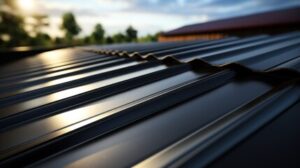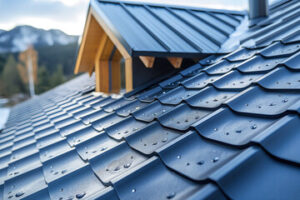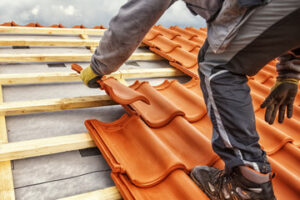Whether you’re replacing an existing roof or building your home from scratch, Bixby Metal Roof adds value to your structure. It’s also known for its durability and energy efficiency.

A well-designed and maintained metal roof can last for 50 to 75 years. This durability is largely dependent on local weather conditions, regular maintenance and proper installation techniques.
When it comes to roofing materials, many homeowners seek a durable option that holds up well under changing environmental conditions. Metal roofs are well known for their longevity, even surviving hurricane-force wind gusts, and they can last up to 50 years or more. They also require less maintenance than traditional asphalt shingles. In addition, a well-maintained metal roof can boost the curb appeal of a home and add value to the property.
Despite the perception that metal roofs look dull, manufacturers now offer textures, finishes and colors that match many architectural styles. The most common options include corrugated panels, flat and ribbed metal and smooth and textured surfaces. These designs can complement siding, trim and nearby trees and shrubs. Some styles have color coatings that mimic wood grain or stone, and these combinations add visual interest to a home’s exterior.
Manufacturers treat panels with specialized coatings that resist corrosion, rust and dents from hail. They may also use a layer of underlayment to protect the roof deck and help prevent leaks. In addition, they install clips that accommodate a roof’s expansion and contraction throughout the year. Fasteners can be concealed or exposed based on the panel design and installation preference.
Some metal roofing solutions feature a high level of fire resistance and meet stringent code requirements, such as Class A fire ratings. This protection enhances the safety of people and pets living in a building and can lower insurance rates. The durability of a metal roof also helps reduce heating and cooling costs, making it a wise investment for a household.
While many metal roofs don’t need regular sealing or shingle replacement, they do benefit from periodic inspections. These routines can spot loose screws, poor seals and other issues before they cause water damage. In addition, they can remove debris like leaves and pine needles that build up under the roof. Many metal roofs resist moss and mildew as well, so owners don’t have to worry about patches of green growing across the surface.
These features make metal a top choice for a balanced blend of function and style. A well-maintained metal roof can last for decades and enhance the beauty of a home or commercial building.
Safety
Regardless of whether a homeowner chooses to have a professional complete metal roof installation or take matters into their own hands, safety should always be the top priority. Taking the proper precautions and using appropriate tools ensures that any work done on a metal roof is completed properly, safely, and to the highest quality standards.
Roofing is a dangerous job, especially when workers are on a ladder or scaffolding, and metal roofs add additional dangers with their sharp edges and protrusions. In addition to proper PPE and personal protective equipment, other important considerations include having a full emergency kit ready, preparing for weather changes, and practicing frequent communication with crew members to ensure everyone stays safe and informed.
The sound of constant clatter is often one of the most common barriers to homeowners embracing metal roofs, but it can be mitigated with simple steps. Investing in acoustic insulation and replacing any loose fasteners that have worked themselves loose can dramatically reduce the noise of a metal roof.
Another way to minimize the rattling of a metal roof is to install an overhang that extends the length of the home. This extra protection prevents rain and snow from pounding against the roof. Finally, installing a metal roofing system that features interlocking panels and an integrated underlayment helps to reduce noise from wind, rain, and other weather elements.
While there are several options for a metal roof, steel is generally the most popular choice due to its durability and energy efficiency. Some homeowners opt for standing seam panels, which are available in a variety of seam heights and rib profiles to accommodate various design aesthetics.
Other popular options for a metal roof include stone-coated metal, which offers the timeless look of a Tuscan villa without the risk of cracking that can come with traditional tile; and aluminum, which is an excellent option for coastal homes since it won’t rust as easily.
Regardless of which type of metal roofing is chosen, it is essential to regularly inspect the roof for any signs of wear and tear. This includes assessing the condition of all the fasteners and ensuring that no nails or screws are loose or protruding. Performing this inspection semi-annually will prevent any potential problems down the road and help ensure that your metal roof stays in optimal condition.
Aesthetics
Metal roofs have a distinct aesthetic that makes them an attractive roofing choice for many homeowners. Their sleek, reflective surface and minimalist approach complement modern home and commercial designs. The range of color options also offers an array of design possibilities that align with specific architectural styles.
Color and style are just as important as durability and energy efficiency. The right color can enhance the look of your home, while boosting its curb appeal and increasing its value. The roof’s color can even help you save on energy costs by reflecting sunlight and reducing cooling bills.
There are a variety of colors to choose from, including neutral hues that suit almost any architectural style. Lighter colors offer the added benefit of reducing energy costs by absorbing less heat. Additionally, there are metal roofing options that mimic the appearance of wood and slate, giving your home a more natural and rustic aesthetic.
In addition to offering an attractive visual profile, metal roofs are also highly durable. They are able to withstand severe weather conditions, making them the ideal roofing option for areas prone to rain, wind, and snow. They also provide excellent protection against sun and UV damage, which can extend the life of your roof.
Metal roofs are also a good choice for historic buildings, as they can be designed to seamlessly blend with the existing architecture. The use of a metal roof can allow preservationists to strike the perfect balance between maintaining the authenticity of a historical building while using more modern construction methods and materials.
While some people may think that a metal roof is visually dull, manufacturers now offer unique textures, finishes, and colors to make the roofing system stand out. A custom-colored metal roof is a great way to add curb appeal to a property, and it can also boost its value. Moreover, real estate agents often highlight the presence of a metal roof in listings.
When deciding on the right color for your metal roof, consider the local climate and any energy efficiency requirements. For example, lighter colors reflect sunlight and can keep your home cooler, while darker colors absorb more heat. You should also check for local neighborhood or HOA regulations that might influence the color you select.
Installation
When installed correctly, metal roofs are durable, energy-efficient, and provide a clean, modern aesthetic. They can also protect your home from water damage and add value to it. Whether you’re replacing an existing roof or starting fresh with new construction, the right roof is essential to your home’s longevity and function.
Metal roofs consist of panels that are flat or coiled and fastened to the roof deck using either rivets, screws, or nails. Some are exposed and others concealed, allowing you to choose what style best suits your design preferences. You can also add extras like a gutter system to manage the run-off of rain and snow.
There are many types of metal roofing materials to consider, including aluminum, galvanized steel, stainless steel, and zinc. Some of them can be recycled, which makes them an eco-friendly choice for homeowners. They’re also available in a variety of colors and finishes, so you can match them to the rest of your home’s décor.
The most common type of metal roofing is aluminum, which comes in both corrugated and flat styles. It’s easy to install, lightweight, and has a long lifespan. In addition, it’s resistant to fire, mildew, rusting, and insect infestation.
Other popular metal roofing options include copper, galvanized steel, and stainless steel. Copper is more expensive, but it’s also more durable and beautiful than other types of metal. It can be found in a range of different colors and finishes, from dull gray to a shiny mirror-like finish.
A metal roof can save you money on energy bills by reflecting sunlight and keeping your home cooler in warm climates. It can also reduce noise and prevent mold and rot. However, it’s important to assess your climate and personal style before choosing a specific color.
Before you start your project, it’s critical to have the right tools and safety equipment. You should also consult a professional roofing contractor to ensure that your roof is properly installed and safe from damage and leaks. They will make sure all the panels are correctly positioned and secured, preventing gaps and misalignments that could lead to leaks. In addition, they will take care of critical components like the drip edge and ridge cap, ensuring that your roof is protected from moisture penetration.

